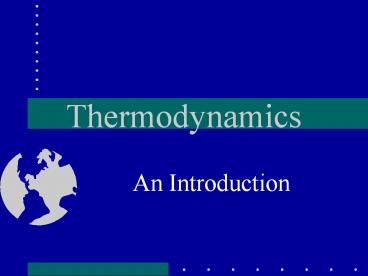Thermodynamics - PowerPoint PPT Presentation
Title:
Thermodynamics
Description:
Title: Thermodynamics Author: Peggy Bertrand Last modified by: Terri McMurray Created Date: 3/6/2000 10:04:10 AM Document presentation format: On-screen Show (4:3) – PowerPoint PPT presentation
Number of Views:242
Avg rating:3.0/5.0
Title: Thermodynamics
1
Thermodynamics
- An Introduction
2
Total energy
- E U K Eint
- U potential energy
- K kinetic energy
- Eint internal or thermal energy
3
Temperature
- Measure of kinetic energy of molecules.
- Difference in temperature causes heat energy to
be exchanged between bodies in contact.
4
Heat
- Internal energy transferred between bodies in
contact. - Temperature difference drives heat transfer.
5
Thermal Equilibrium
- Occurs when two bodies are at the same
temperature. - No heat is transferred between bodies in thermal
equilibrium.
6
Ideal Gas Law
- P1V1/T1 P2V2/T2
- P1, P2 initial and final pressure
- V1, V2 initial and final volume
- T1, T2 initial and final temperature (in Kelvin!)
7
Ideal Gas Equation
- PV nRT
- P pressure
- V volume
- n number of moles
- R gas law constant
- T temperature in Kelvin
8
Ideal Gas Equation
- PV NkT
- P pressure
- V volume
- N number of molecules
- k Boltzmans constant
- T temperature in Kelvin
9
Ideal Gas Equation
- R NAk
- R ideal gas constant
- 8.31 J/mol K
- NA Avagadros number
- k Boltzmans constant
- 1.38 x 10-23 /mol K
10
1
- Gases consist of a large number of molecules that
make elastic collisions with each other and the
walls of the container.
11
2
- Molecules are separated, on average, by large
distances and exert no forces on each other
except when they collide.
12
3
- There is no preferred position for a molecule in
the container, and no preferred direction for the
velocity.
13
Average Kinetic Energy
- Kave 3/2 kBT
- Kave average kinetic energy (Joules)
- kB Boltzmanns Constant (1.38 x 10-23 J/K)
- T Temperature (K)
14
System
Environment
15
Boundary
- Doesnt let mass in or out.
- May or may not let in heat.
- May or may not let the system be compressed or
allow it to expand.
16
First Law of Thermodynamics
- ?U Q W
- ?U change in internal energy of system
- Q heat added to the system
- W work done on the system
17
Isothermal Process
PV nRT
DT 0 (constant T)
18
Isobaric Process
PV nRT
DP 0 (constant P)
19
Isometric Process
PV nRT
DV 0 (constant V)
20
Adiabatic process
Q 0 (insulated)
21
Work done BY gases
Wgas p?V
Positive work
?V
Wenv -p?V
Negative work
22
Work done ON gases
Wgas p?V
Negative since ?V is negative
Wext -p?V
Positive since ?V is negative
23
Work at constant pressure
WAB gt WCD
P
P2
Where we are considering work done BY the gas
WAB p2?V
P1
WCD p1?V
V
24
Work is path dependent
WABD gt WACD
P
Where we are considering work done BY the gas
WABD
WACD
V
25
Second Law of Thermodynamics
- No process is possible whose sole result is the
complete conversion of heat from a hot reservoir
into mechanical work. - - Kelvin-Plank statement
26
Second Law of Thermodynamics
- No process is possible whose sole result is the
transfer of heat from a cooler to a hotter body. - - Clausius statement
27
Heat Engines
- Convert heat into useful work.
- Always have waste heat.
- Efficiency can be used to tell how much heat is
needed to produce a given amount of work.
28
Heat Transfer
QH QC
29
Heat Engines
Engine
QH QC W
30
Clarification
- A heat engine is not something that produces
heat. A heat engine transfers heat from hot to
cold, and does mechanical work in the process.
31
Isothermal vs Adiabatic Expansion of Gases
W ?U
32
Carnot Cycle
QH QC W Efficiency W/QH
Work
33
Efficiency of Heat Engine
- Efficiency W/QH
- (QH - QC)/QH
- Carnot Efficiency (TH - TC)/TH
- Efficiency Efficiency100
34
Entropy
- is disorder, or randomness. The entropy of the
universe is increasing. - Sort of like the entropy in your room.
35
Entropy
- ?S Q/T
- ?S Change in entropy (J/K)
- Q Heat going into system (J)
- T Kelvin temperature (K)

